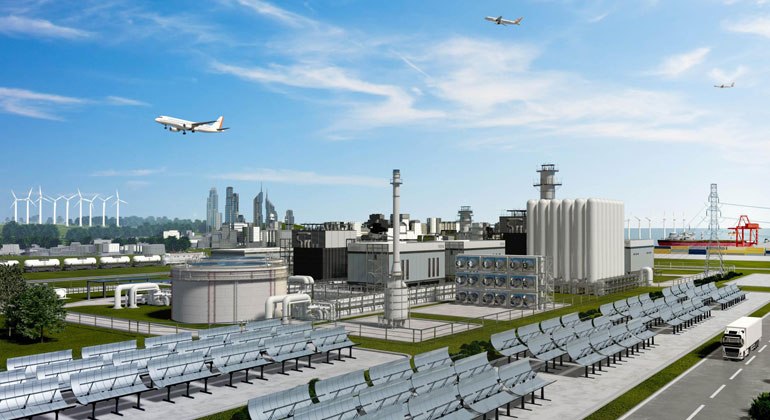PtL technology platform – DLR research addresses the industrial production of electricity-based fuels
Electricity-based fuels – also referred to as e-fuels or power-to-liquid fuels – will be able to make an important contribution to transitioning the energy, mobility and industrial sectors towards becoming climate and environmentally compatible.
With the Technology Platform PtL (TPP), the German Aerospace Center (Deutsches Zentrum für Luft- und Raumfahrt; DLR) is taking a decisive step toward advancing technologies for the production of electricity-based fuels – also known as Power-to-Liquid fuels (PtL) or e-fuels – on an industrial scale. The aim of the project is to close the gap between development and industrial market ramp-up and support the market launch of these fuels. Electricity-based fuels, in addition to alternative propulsion systems and other possible improvements, are necessary to achieve ambitious climate protection targets, particularly in the mobility sector.
On 14 March 2023, the Federal Ministry for Digital and Transport (Bundesministerium für Digitales und Verkehr; BMDV) announced that DLR was the successful candidate for the development of such a platform. For the planning phase of the PtL technology platform, DLR will receive approximately 12.7 million euros from the BMDV. Further funding for DLR for the subsequent implementation phase will be decided upon at the end of 2023.
“Electricity-based fuels are our best option for quickly and significantly reducing the climate and environmental impact of long-haul flights. We know how to achieve this and now we are getting started by bringing the necessary technologies from the laboratory into industrial application. The PtL Technology Platform is a crucial milestone for upscaling. It will contribute to securing the future of the industrial and mobility sectors in Germany and Europe,” said Anke Kaysser-Pyzalla, Chair of the DLR Executive Board.
Oliver Luksic, Parliamentary State Secretary at the BMDV, explained: “In order to advance e-fuels on the path towards market ramp-up, we need the concentrated expertise from theory and practice, from science and industry. To this end, we are relying on a demonstration platform on a semi-industrial scale. Here, participants along the entire supply chain can work hand in hand to scale up and optimise e-fuel technologies. I am pleased that we have been able to gain a networked and experienced research partner in DLR, which will set up the demonstration platform as a large-scale research facility and make it available to third parties.”
Largest research facility for the production of electricity-based fuels
The TPP will close the gap between research and industrial production. It will consist of two plant sections that complement one another. In the research section of the plant, DLR will test novel technologies and processes with other stakeholders from academia and industry. The researchers will conduct detailed scientific analyses and optimise individual components. The focus of the demonstration section will be on the operation of a semi-industrial plant for the production of electricity-based fuels with a capacity of up to 10,000 tonnes per year. This would make the TPP the world’s largest research facility in the field of electricity-based fuels. A modular design is planned for the demonstration section. This will allow different production methods and the technologies and the components they require to be investigated and compared in terms of their practicality. This is a particularly important step – not everything that works on a small scale in the laboratory can simply be scaled up for industrial production.
Focus on the entire process chain
The TPP’s range of topics extends from renewable energy as a source of electricity-based fuels, through to the certification and demonstration of the use of these fuels. The project relies on DLR’s comprehensive expertise along the entire process chain and its many years of experience in the areas of fuel design – the development of fuels with maximum performance and minimum climate and environmental impact – techno-economic analysis, the development of production methods, the integration of electricity-based fuels into the overall energy system, and the acquisition of application and emission measurements using specialised DLR research aircraft.
Fuel design – targeted fuel development also reduces effects not related to carbon dioxide
Electricity-based fuels have the potential not only to greatly reduce carbon dioxide emissions, but also to significantly reduce non-carbon-dioxide effects. These include emissions of nitrogen oxides, soot particles and water vapour. In air transport, the non-carbon-dioxide effects are currently approximately twice as significant as the climate impact of the released carbon dioxide. Soot particles and water vapour, for example, can lead to the production of contrails in the atmosphere, which have an additional warming effect. “Electricity-based fuels offer another advantage in this context – fuel design. We can optimise the chemical composition of these fuels to ensure that their combustion process no longer produces soot or particulate matter, for example. This also improves the local air quality,” says the head of the TPP project, Manfred Aigner, from the DLR Institute of Combustion Technology in Stuttgart.
What are electricity-based fuels?
Electricity-based fuels – also referred to as e-fuels or Power-to-Liquid (PtL) fuels – are liquids. To produce them, carbon is used, for example from the air, and hydrogen, which is obtained by means of electrolysis. If the electricity used is produced using renewable resources such as wind or solar energy, the fuels produced in this way are climate neutral. This means that they only release as much carbon dioxide during the combustion process as was previously captured during their manufacture.
In the long term, many mobility sectors will be dependent on large quantities of liquid energy sources. These include air transport and shipping in particular, but also vehicles that cannot be easily electrified because they are very heavy or have to cover long distances.
Another advantage of electricity-based fuels is that they can be transported, distributed, stored and used largely with existing infrastructure and vehicles or aircraft.
Source
DLR / Deutsches Zentrum für Luft- und Raumfahrt 2023 | Foto: DLR / Credit: DLR (CC BY-NC-ND 3.0)








